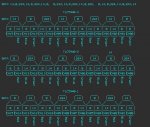Hi there!
This is my first post, and yes I have searched the whole forum on 'RGB LED', 'PWM LED' ... etc. There was nothing found, hence this posting
Down to business :-
I have searched t'internet and discovered that there are a few PIC based projects that can control RGB LED's (Red Green Blue Light Emmiting Diodes) using RS232 serial data. They are based upon the microcontrollers that the PICAXE is using. Using PWM (Pulse Width Modulation) through MOSFETs (Metal Oxide Silicon Field Effect Transistors) to alter the brightness of each of the three LED's, or each die in a common cathode or anode package.
Looking at the documentation and specifications for the entire PICAXE range it seems as though there are only a maximum of 2 outputs that can be 'background' PWM outputs.
I know that one can control stepper motors (servos) with up to 8 outputs but the ratio is only variable between 1:2000 to 1:8. This is not enough to drive LED's between off and an acceptable level of brightness.
What I wish to do is control an RGB LED (or three individual LED's) from a serial data line (RS232) to generate 'any colour' (well actually 8 bits per R,G, or B).
As one does not have access to the lowest level of the PIC, then trying to write my own accurately timed PWM loop may be impossible.
I may be missing something - I hope I am - but it seems as though the entire PICAXE range is unable to do this!
It would be great to utilise existing the PCB's (Printed Circuit Boards) and the obvious support that PICAXE provides with such a well designed system.
It is well within my expertise to program and construct the project, but there is no point in re-inventing the wheel, especially if there is a way to control 3 PWM outputs. I don't enjoy etching PCB's but I do enjoy getting something working quickly ;-)
I would appreciate this forums' thoughts on this matter.
Regards
Rob.
Note:-
The 'UK' based site that achieves what I wish to do is here -
http://picprojects.org.uk/projects/simplergb
The 'US' based site -
http://www.rgbled.org/
This is my first post, and yes I have searched the whole forum on 'RGB LED', 'PWM LED' ... etc. There was nothing found, hence this posting
Down to business :-
I have searched t'internet and discovered that there are a few PIC based projects that can control RGB LED's (Red Green Blue Light Emmiting Diodes) using RS232 serial data. They are based upon the microcontrollers that the PICAXE is using. Using PWM (Pulse Width Modulation) through MOSFETs (Metal Oxide Silicon Field Effect Transistors) to alter the brightness of each of the three LED's, or each die in a common cathode or anode package.
Looking at the documentation and specifications for the entire PICAXE range it seems as though there are only a maximum of 2 outputs that can be 'background' PWM outputs.
I know that one can control stepper motors (servos) with up to 8 outputs but the ratio is only variable between 1:2000 to 1:8. This is not enough to drive LED's between off and an acceptable level of brightness.
What I wish to do is control an RGB LED (or three individual LED's) from a serial data line (RS232) to generate 'any colour' (well actually 8 bits per R,G, or B).
As one does not have access to the lowest level of the PIC, then trying to write my own accurately timed PWM loop may be impossible.
I may be missing something - I hope I am - but it seems as though the entire PICAXE range is unable to do this!
It would be great to utilise existing the PCB's (Printed Circuit Boards) and the obvious support that PICAXE provides with such a well designed system.
It is well within my expertise to program and construct the project, but there is no point in re-inventing the wheel, especially if there is a way to control 3 PWM outputs. I don't enjoy etching PCB's but I do enjoy getting something working quickly ;-)
I would appreciate this forums' thoughts on this matter.
Regards
Rob.
Note:-
The 'UK' based site that achieves what I wish to do is here -
http://picprojects.org.uk/projects/simplergb
The 'US' based site -
http://www.rgbled.org/






